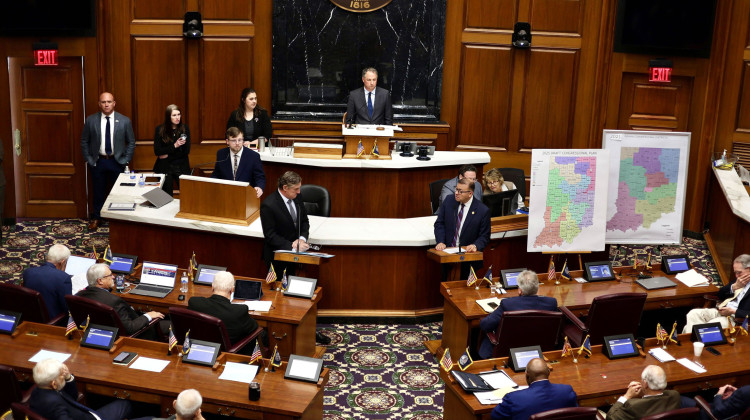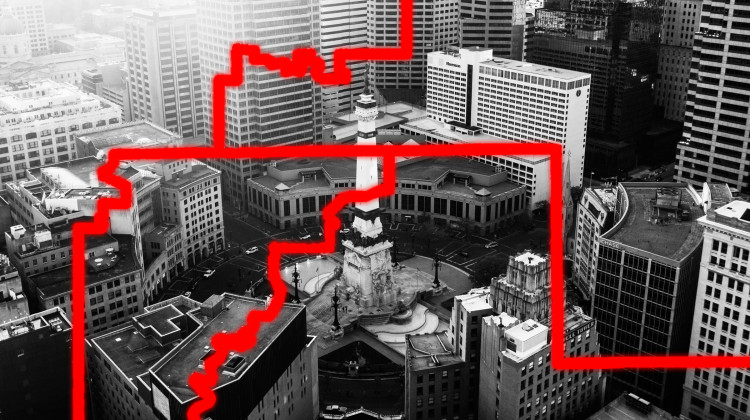Public and private efforts to transform the White River and its Indianapolis banks are ongoing, through a variety of developing projects.
As part of a series of stories about how the river is being reimagined, WFYI’s Jill Sheridan sat down with Sarah Hempstead, CEO of Schmidt Associates and Visit Indy board member, to learn more about long-term goals.
This interview was edited for length and clarity.
Jill Sheridan: What can the White River look like in Indianapolis? What can we do to develop it to make it more of a part of the city? How did you become involved in these efforts?
Sarah Hempstead: Well, I mean, really, the White River Initiative is a placemaking initiative. And I've been involved in that since I relocated to Indianapolis in 1998. When you talk about placemaking, you talk about what makes a place authentic, what makes it special, both for visitors and for the people who live and work and play here every single day, like me and my family.
And around 2018, 2019, I was asked to join the Visit Indy board, specifically tourism tomorrow, which is the arm of Visit Indy that works on exactly that, you know, how do we look at long range placemaking projects and make sure that there is energy and enthusiasm and visionary leadership there to make placemaking projects possible.
Because one of the difficulties of big projects like that, like the White River ,is they take a really long time, they need to span multiple administrations, they need to span multiple communities and governmental structures in order to make them happen.
Sheridan: Recently there was a trip city officials, private citizens, like yourself, went on a trip to Singapore to sort of see, I guess, you know, pie in the sky kind of ideas. What did you learn, what was that like?
Hempstead: So it seems crazy, I know, to go all the way to the other side of the globe. But Singapore really is best in class when it comes to tourism dollars and waterfront development. So what they have done really over the course of our lifetimes is large scale transformative projects that they built with buy-in from their population.
You could tell that everywhere they are teaching, even at the littlest ages, why this kind of investment is important. They've taken their waterfront, they've cleaned it. So there's an eco-story there that certainly we can learn from here in Central Indiana.
Most notably, there is a Garden of the Bay project, which if you've seen Crazy Rich Asians, you have seen this project development, one of the most amazing botanical gardens I have ever seen. And they've used that billion dollar tourism investment to spur visitors. They're one of the most popular spaces to visit in that area of the world, and also to enrich the lives of the people who live there every single day.
Sheridan: I have seen the movie, incredible. So when we're thinking about Indianapolis, our legacy with the White River, what are some of those dream projects that we might aspire to?
Hempstead: Well, so that's what's really important, right, is not that we build our own Gardens by the Bay, because that is authentic to Singapore, it would not be authentic here. But we work with the local communities that live in the river, and we take advantage of the major investments that are happening right now.
Like the Elanco project, these major capital investments are happening, along with our current eco initiative to clean the river. That we take advantage of all of these things, and we tie them together into one cohesive special place that couldn't be anywhere else it has to be in Central Indiana.
Sheridan: It is about that vision, you know, everybody would love to see the White River transformed in the downtown area. What is realistic and actual change that could we maybe see, you know, in the immediate future?
Hempstead: Well, I think if you've gone to the White River last time, or you would have seen Belmont Beach, the first of a trial of implemented experiences, you're gonna see that area improved and growing. And that's a really cool story because it really was working with the residents who live there to make a place that is special and authentic.
And then as the stamping plant gets redeveloped into more parkland, as the White River State Park jumps the river for the first time, this is the first time the White River State Park has been able to actually touch the water. You're gonna start to see more opportunities for people and nature to interact.
And then again, as you see big initiatives that give you some place to go when you're down on the park and at the water, this is really going to be transformational. It's going to be totally different in 20 years than it is today.
Sheridan: Thank you, Sarah so much for coming into chat today.
Hempstead: Thanks so much.
 DONATE
DONATE








 Support WFYI. We can't do it without you.
Support WFYI. We can't do it without you.